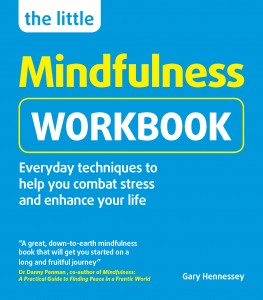Being mindful can make us aware of how we make ourselves suffer unnecessarily, says expert Gary Hennessey, author of The Little Mindfulness Workbook…
Someone pushes in front of you in a queue, your printer won’t work, your car breaks down, someone is dismissive at work, or God forbid, its raining on a Monday morning. We encounter many situations daily that test us. ‘For one person, being stuck in a traffic jam is hell. For others, it’s nothing’, says Gary Hennessey, a teacher in mindfulness for 35 years and author of new book, The Little Mindfulness Workbook.
Often people think mindfulness is about being calm, or as relaxation, but it’s not.
‘Being mindful allows people to see more clearly what it is they are doing that is causing them to suffer unnecessarily’, says Gary, also leader at Breathworks who provide mindfulness courses. ‘Often people think mindfulness is about being calm, or as relaxation, but it’s not. Its much deeper than that’. He continues to explain that mindfulness isn’t about getting somewhere else, but being aware of where you are, and your relationships with your experiences. By focusing more on our senses, you can restore clarity, kindness, and calm to life, reducing stress by around 40 percent according to one study by Oxford University.
For a beginner, mindfulness can be hard to get your head around. But the practise of it can be implemented in hundreds of ways in many situations, from brushing your teeth, to eating a meal. In fact, a recent study by Commuters Club found that more than one in 10 people practise mindfulness during their work commute. Using these ten fundamental principles from The Little Mindfulness Workbook, see if you can progress to a more mindful you:
-
Respond, not react
You may feel irritated whenever you’re caught in a traffic jam or your train is running late. No matter how irritated or impatient we come, it won’t change the situation. Irritation is the natural habitual reaction, but the response is conscious and chosen.
Mindfulness doesn’t give us a choice to what happens to us, but how to respond to it.
Mindfulness doesn’t give us a choice as to what happens to us, but how to respond to it. The first step in moving from reaction to response is to notice what’s actually happening, which is an unpleasant situation. We instinctively try to resist these situations, even when we can’t do anything about them.
The first step in moving from reaction to response is to notice what’s actually happening
Your emotions about it, such as ‘This is ridiculous’, ‘Come on, get a move on’, can escalate to ‘There are too many cars on the roads these days’ or ‘The transport minister is hopeless’. This leads to unnecessary suffering, what is called the secondary experience. Mindfulness is the practice of distinguishing the secondary experience, the emotions and judgements, from the primary experience, being the direct experience: what it feels, looks, sounds, smells, or tastes like.
2. Thoughts aren’t fact
Not everything we think is true or helpful, and mindfulness helps us to notice our thoughts without necessarily taking them as truth or buying into them. Some of our thoughts can cause us to suffer unnecessarily if we believe them. When stressed at work, you may think ‘This is too hard, I can’t do it’. This may not be true, or at least the second part, but you may believe it and give up, leading to another thought: ‘I’m not much good at anything’- almost definitely untrue- which may give rise to the thought: ‘I’m a failure’- definitely untrue. This can lead to a state of depression or self-doubt. With practice, you can notice these thoughts and let them go.
3. You are a human being, not a human doing
A distinction made in mindfulness practice is between doing and being modes of mind. Doing mode is the mindset that strives after goals. It’s not satisfied with the way things are going right now, but tries to improve them. It notices the problems and tries to fix them. Therefore, doing mode tends to be future-oriented, working towards the goal it has set, the improvements it wants to make, the problems it tries to solve. But it is also associated with evaluating, comparing and analysing things.

Being mode is oriented to the present moment. When we’re in being mode we experience the present moment directly in all its fullness and richness- and imperfections- and we don’t feel any great need to change it or achieve anything. Instead, we’re interested in and curious about our experience. We use our senses and are aware. Being mode still leads to change, often to profound and far-reaching change- but it does so in a different way from doing mode.
When we’re in being mode, rather than doing mode, we experience the present moment directly in all its fullness and richness
People spend more time in doing mode. One way to convert to being mode is to do things a little slower than normal. This allows us to get out of the attitude of doing things only in order to get them done, and allows us to appreciate the doing of them.
4. Focus on positives as much as negatives
We have what neuro-psychologists call a negativity bias in the brain, a strong tendency to notice and dwell on negative events and experiences. This is an evolutionary thing that we have inherited, and we notice the negative before anything good. It has worked well for our survival in the past, but it doesn’t help us enjoy a sense of well-being, tranquillity or happiness.
We tend to remember negative experiences more because our cave-dwelling forbear’s had to notice dangerous experiences more so they could run form them
We also tend to remember negative experiences more, again because our cave-dwelling forbear’s lessons were always learnt from negative or dangerous experiences, than positive ones. We need to work against the negativity bias, by turning our attention to the pleasant experiences. This isn’t just ‘thinking positively’, but looking at our situation in a more balanced way. The next time you are praised at work or someone smiles at you, stay with the experience for 10-20 seconds and remember how it made you feel.
5. Take breaks, even for a minute
Its fine to have a full life, but a life of constant activity isn’t good for us. It keeps us locked in doing mode and is one of the main causes of anxiety, stress, and irritability. When we are constantly on the go we tend to get frazzled, our minds get tired, and we end up paying less attention to the tasks in hand. We then don’t do as good a job as we are capable of.
Stop whatever you are doing a number of times a day. Give yourself permission to do nothing and rest.
Stop whatever you are doing a number of times a day. Give yourself permission to do nothing and rest. They don’t have to be long breaks, a minute, 30 seconds, or just a few breaths. But in the end regular breaks will make you more efficient. If the thought ‘I don’t have time for this’ pops into your mind, don’t let it take hold of you. If you believe it, you’ll probably stop what you’re doing and start working, despite a few minutes before you thought that you did have time to do it.
6. Don’t resist difficult experiences
Let’s say you have had a row with your partner. They said a number of hurtful things and you retaliated in the same way. Now you’re feeling hurt, guilty, and nervous about seeing them later. If you try and meditate, you’ll most likely to play the row over and over in your mind. Even if you control your breathing with exercises, thoughts about what they said, what you wish you’d said, will creep in. Your feelings about the row are calling for your attention, but what we usually do it pay attention to the thoughts, rather than going beneath to the emotions.

We tend to try and get from A (where you currently are), to B (a better state). If you want to get from A to B, you have to really be at A first. Have you ever tried to not feel anxious when you’re feeling anxious? It probably didn’t go to plan, as what we try to resist, tends to persist. We need to feel the anxiety and explore it, allowing B (calmness) to come to us through mindfulness, rather than us trying to get there. A is our primary experience, and we must calmly accept the way things are right now. Accepting means to ‘take or receive willingly’, not accepting it so that it will go away. Eventually in time it will, but it’s important to remember mindfulness has no quick fixes.
You may get to B but still feel A is there. You’re now experiencing your anxiety in a calmer way, but with continued practise of being mode, you’ll strengthen the state of calm.
Sometimes, of course, accepting something doesn’t make it go away. If A is chronic physical pain, being at A isn’t going to take you to a pain-free B. But other principles of mindfulness such as letting go of unhelpful thoughts and negative emotions, our primary experience will become easier to bear.
7. Turn up your ‘green system’
There are three emotional systems:
- The red system: self-protection or threat
This includes emotion of fear, anxiety, anger, and disgust. It is connected to the negativity bias, and we can get stuck in the red system as our brain prioritises dealing with threats than opportunities.
- The blue system: resource-seeking or drive
This motivates to seek and get good things in life, and then we are rewarded by feeling good.
- The green system: contentment
This is activated when we feel safe and don’t want or need anything. These feelings include peacefulness and fulfilment, and emotions that connect us to others: gratitude, compassion, affection.
What system do you spend the most of your time in? There are negatives to each, but the red and blue systems are about changing the current state of things, rather than experiencing them, as you do in green. The systems both have upsides and downsides, but modern society values the red and blue systems much more, not allowing us to ‘turn up the green’, and relax.
8. Be kind to yourself
Having a positive attitude towards yourself allows you to admit their failings
Perhaps you believe being self-critical stops you from being lazy and helps you to improve? However, evidence shows those who practise kindness meditation are able to acknowledge their mistakes, imperfections, and negative actions, better than those who don’t. Having a positive attitude towards themselves allows them to admit their failings without being overwhelmed with negativity.
When we criticise ourselves, our red system is turned up, activating emotions of fear, anger, or even self-disgust. These emotions do not help us become better.
When we are criticised, or we criticise ourselves, the red system (see point before), is turned up, activating emotions of fear, anger, or even self-disgust. These emotions do not help us become better.
9. Be mindful of other people’s feelings

To be mindful of other people means being aware of them as subjects and not objects, which means feeling for and respecting, empathising, or at least taking into account, their feelings, points of view, desires, etc. Like you, people don’t want to suffer, and they want to be healthy and happy.
This can be difficult for people we don’t know much about, so it’s important to use imagination: this person has a life as important to them as your life is to you. Some people can be difficult, and it’s tempting to try and change them. But its less frustrating to simply let them be with all their faults.
When people are critical of us, or treat us badly, we can become defensive or offensive, making the situation worse. Its best to try and feel the pain of the other person’s behaviour, but step back a bit, and act with a little more wisdom than perhaps if wed acted out of defence. We can still stick up for ourselves, but it’s more effective from a calm and emotionally stronger place.
10. Avoid the exhaustion funnel
If you’re overloaded, you may end up dropping things that aren’t essential, or that won’t let others down. These things are normally going to the gym, watching a film, reading a book. In other words, something that nourishes us.
We can often strip back our life to the things we do just to stay alive, but these things are our sustainers
By the end of the week, you may feel more tired and a little low, because you didn’t do anything that nourishes you, only things that deplete you. If we aren’t careful, we can often strip back our life to the things we do just to stay alive- work, clean, shop. We can fall down a slope until we are burnt out. It is often conscientious workers who are likely to fall down the exhaustion funnel, as their level of self-confidence is closely dependent on their performance at work.
Ask yourself if your life’s drainers outweigh your life’s sustainers, or vice versa. Sometimes it’s a matter of how much time you spend on each, or how much effect they have.
Three simple mindfulness techniques to try
Do these exercises by reading an instruction, spending some time exploring the instruction with your eyes shut and being aware of your breath, before reading the next instruction.
You can also listen to some of these at: https://soundcloud.com/breathworks-mindfulness/sets/the-little-mindfulness-workbook.
-
Drinking a hot drink
First, hold the cup or mug in your hand and gaze at it… Notice the way the light and shade falls on it… Is it lighter on one side than on the other?… Notice how it reflects light, and the different colours the reflections give to it. For instance, if it’s a white mug, is it just one shade of white all over, or is it many shades, many colours?…
Now look at the surface of the drink itself. Notice the colours, the reflections, the shades… Notice the steam coming off it…
Now feel it in your hand, the sensations on your skin, the heat, the weight of it…
Now bring it up to your nose and breathe it in – does it have an aroma? Perhaps close your eyes to better concentrate on its smell… it may be strong, or it may be very subtle…
As youre doing this youll probably also feel the steam on your face… If you want to feel that more fully, put the cup underneath your chin…
If you’re thirsty, notice the feeling of wanting to drink… Be curious about that sensation… What does thirst feel like? What does the urge to do something feel like?…
Maybe there’s some impatience too, what does that feel like?…
OK, bring the cup to your mouth… feel the rim of the cup on your lips… what does that feel like? Now take a sip, and hold the liquid in your mouth for a few seconds… what does the liquid feel like? And the taste?…
Now swallow if you haven’t already done so. Feel the drink slip down your throat… The feeling of satisfaction as you do so…
In this exercise, you have paid attention, used more than one sense, and were aware of the present experience.
2. The body scan
This takes around 20 minutes. Lie down on a bed and make sure you won’t get cold or be disturbed
Become aware of your body as a whole, from the head to the toes… Feel its weight against the matts or the floor beneath you… Have a sense of the whole of your body: its weight, its temperature, how it feels…
Then become aware of the breath… feel it entering and leaving the body… Feel the chest and the stomach rising and falling as the breath comes in and goes out… You may notice other parts of the body moving slightly with the breath- the back, the shoulders, even the arms or legs…
Now take your attention to each part of the body, letting your awareness rest in each part for a while. You can start with the head and work slowly down the body to the feet, or vice versa. As you become aware of each area, see if you can accept whatever sensations are present. Some parts may feel relaxed, warm and comfortable, while others may feel tense, uncomfortable or even painful. Some other parts may feel numb. The practise is just to feel whatever sensations are there, just as they are…
If the sensations are pleasant, see if you can experience them without trying to hold onto them. If they are unpleasant, as best you can, accept them without trying to push them away, breathing into them, softening around them…
Once you’ve moved through the whole body in this way, broaden your awareness to include your whole body once again…
Sit or lie for a few moments, doing nothing at all, and then mindfully get up and see if you can take this awareness into the rest of your day.
3. The mindfulness of breathing
Sit in a comfortable, upright posture (use a straight-backed chair, with your hands rested in your lap or on a cushion, with your feet flat on the floor).
Spend a little time becoming aware of your body, the sensations of contact with the chair or cushion and the floor… feel that contact…
Can you feel your clothes resting on your skin?… Can you feel the air temperature on your skin?…
Notice all the sensations, and allow them to be just as they are, whether unpleasant or pleasant, or somewhere in between…
Now rest your awareness on the sensations of breathing… your chest expanding and contracting… your belly swelling and subsiding… your abdomen…
Whenever your mind wanders, once you notice that, bring it back to your breath, gently and patiently…
Now take your attention to your back… the back also moves as we breathe, although these movements are quite subtle… if you’re sitting with your back supported, perhaps by the back of the chair, you may notice how the feeling of contact with that support changes as you breathe in and out… stay with the movements in your back for a while…
How about your shoulders… can you feel any movement there?…
Now broaden your awareness, so that you’re aware of the whole of your torso moving gently with the breath…
Now take your awareness to the place where you feel the air first entering the body… if you’re breathing through your nose, that will be the tip of your nose, or your upper lip or inside the nostrils… if you’re breathing through your mouth, that will be the lips, the tongue or the roof of the mouth.
These sensations are quite subtle and you may not feel them at first. However, if you continue to pay attention to them, you’ll begin to feel them… Allow your attention to be light and subtle, like a butterfly resting on a flower…
Now broaden you’re awareness once again to include the whole of your body… Sit for a few moments, letting go of all effort…
Now open your eyes, and begin to move. See if you can retain some of the awareness of your breath as you go about your day.

, on Amazon for £7.99
Like this article? Sign up to our newsletter to get more articles like this delivered straight to your inbox.
























































